“To another room came they,
Where children were in poor array,
And everyone sate picking wool,
The finest from the coarse to cull…’
[Visit to Winchcombe’s 16thC factory, quoted in ‘The Spinner’s Workshop’ by John Mercer].
My dad was a Leeds man. Leeds men of his generation – even those not connected to the wool industry – knew a bit about wool. He’d just feel a suit for a few seconds, and announce with disgust:
“Shoddy!”
Meaning it was made from a mixture of virgin wool and waste recycled woollen rags. His father owned a dairy – nothing to do with wool!
Leeds people (‘Loiners’) could do that, spot shoddy on sight. Touch a coat and know instantly if it was wool or something masquerading as.
Here’s grandma, dad and grandad in a Bridlington walking shot on one of their rare days off from the business:

Dad eating chips, Bridlington, 1930s
Over the 27 years or so I’ve been spinning and dyeing, I didn’t realise it til recently, but I’ve probably developed a similar instinctive knowledge when it comes to my sense of touch and wool. It comes with time and practice. Also you have to reach the point where you’re confident in your own abilities!
Here’s how I sort a fleece.
I learned this from books years ago, in the days before YouTube, etc and when books that covered wool sorting for handspinners, couldn’t afford to have many, or colour, illustrations. I sued to sort a fleece with one book or another open at the woolsorting chapter, propped open nearby.
I forget when I was suddenly just wool-sorting, without reference to anything but touch and sight.

My grandma, Lillie Boothman, with lamb
Above: My grandma, Lillie, with a lamb she met at a relative’s farm. She adored this sheep so much she kept a lock of its wool. This would be 1926. I still have it upstairs!
This little series of pictures, this is what I wish I’d had when I started. Ignore my ramblings and words and just look at the pics if that helps – I’m no expert, I have done this for many years but as I say, only learned from books and over time, it became instinctive. Now I see people ask qs on Ravelry and other places and realise this might be useful for some…
Yesterday was a suitably hot and sunny day – ideal for wool sorting/washing as you can do the whole process outside.
And here is the Jacobs fleece I got at the weekend. Jacobs are wildly unpredictable fleeces and honestly, rarely brilliant. Unless you get it from prizewinners like those we photographed months back, when I blogged about Masham Fair. As a result I wouldn’t usually choose Jacobs anymore unless I wanted the colour variation. But I got given this so…
Owt for nowt as my dad and grandad would have said.
First, despite the grass being dry, I spread an old duvet cover on the lawn. It’s bad enough teasng the farmer’s vegetal matter out of some fleeces – so I’m not about to add my lawn clippings!
Yes you’re not meant to keep fleece in polythene. But yes, I do. Bad girl. It’s OK if you poke a few holes in it and don’t leave it in there too long. Once it’s washed it can go into old pillowcases, though.
[Click the Thumbnails if you want really close up gory detail!]
The hardest part of sorting can be unrolling the fleece. Whenever I have messed this stage up – or the shearer rolled it badly – it has always ended in tears. If you can try and unroll your fleece to keep it as intact as possible, the shape of it will help you, and give you clues as to what’s where in terms of wool grades.
You want the cut side (the side facing you before you start to unroll), against the ground and the tips facing you. Eyeball these pics as I unroll and you’ll see what I mean…
Sometimes (usually in fact), they tie the whole woolly bundle round with the neck wool to secure it. In this case, it was secured without a long ‘tie’ of neck wool, but if it is rolled this way be very careful undoing the ‘tie’ as some of that can be your best wool of all!
Here’s the roll partially undone. Notice you can differentiate from the sheared (underside) wool and the tips. This is another clue to help orientate you, whilst unrolling the fleece.
The fleece should be rolled up so the belly wool is either side, and wool from the sheep’s back will be in the middle of the whole fleece, once its rolled out. It will be obvious fairly soon which end is neck and which is rump. The neck wool is usually a long piece. Follow the smell for the rear end!
Sheep are filthy things so you will probably find poo the entire length of the belly, both sides.

Unrolled Fleece
Because this is a bi-colour fleece, I now have a decision to make. I can sort for colour, or can sort for quality. Or… I can sort for both!
Looking at it, this sheep’s markings meant most of its grey wool was close to the neck (best quality wool), but looking at it closely, it was of different qualities, but there is no really poor wool up at the neck end, where it’s grey.
I have no project in mind yet – if I had, then the decision would be made for me. Want to make a shaded jumper like this from Jacobs? You have to sort for colour depth first, staple (wool’s) quality second.
With this particular sheep, there was a strong defined line between most of the grey and most of the white:
So I decided to separate the largest ‘blob’ of grey from the rest, then just sort the rest for its quality.
I can blend all the varying qualities grey seeing as none are spectacularly fine staple, and none terribly coarse. When you separate off the wool, notice staples (clumps of wool) grow in lines or rows almost. Use this to your advantage and separate gently between the ‘rows’, when you can.
If you have a self coloured fleece though you will never have to think about this! All you’re doing then, is sorting into 4 or so broad qualities. For a first attempt I’d try a sort of medium-ish length stapled wool (Say, Cheviot – which also has the advantage of being all one colour).
Now, woolsorters of old had enchanting names for different qualities of wool to be found within a single fleece. ‘Britch’ and ‘”skirtings” and “back” for example. But over the years I have just dropped all that (much as I love the idea of it!) and gone with 1, 2, 3, and 4. 4 is the stuff I’m going to ‘skirt’ off and not even bother with. 1 is the prime, finest, best quality stuff.
Usually you find the majority of a fleece will be 2. Up around the shoulders and neck, you might get 1. But look carefully as it may be elsewhere, especially on the flanks.
Sorting wool for quality seems daunting but a lot of it is common sense. Where bits of the sheep rub together – well that’s like putting your Malabrigo Laceweight in a tumble dryer. It’ll felt! Be coarse. Plus sheep are nothing if they’re not
(a) hell bent on mindless self destruction and
(b) poo factories.
It’s the (b) we’re worried about here.
All round the edges, on both sides you are likely to find poo. You want to skirt that off. Gently use your hands to pull apart the fibres, taking away all the contaminated fleece like so:
Sometimes if the sheep isn’t so filthy, you may have to lose a lot less to the skirting.
Years ago I was so frugal with fleece, I’d wash and keep the skirtings too – but they take SOOOOO much washing that these days I tend to do soak in a bucket of water for a day or so, then tip the liquid ‘fertiliser’ over my roses…
I use the rubbishy wool as mulch on the garden.
I had to go down the bottom garden and look for my old bucket, first. And on my travels, found this gent sat in the kids’ old sandpit:
If you’re more frugal than me you can wash and re-wash til you get the poo out, then sort it into your main categories.
I am now going to sort the remaining fleece into 3 categories.
1 = prime wool
2 = OK wool
3 = poorest quality
As a rough guideline, coarse wool has a different ‘handle’. It may be kempy (hairy), feel coarse – the individual wool staples will be ‘fatter’ and feel a bit more like the sort of ‘limp, lifeless’ hair Cheryl Cole tells us not to have in the L’Oreal ads:
This is what 3 Wool looks like – coarse, and not so crimpy (wavy) . It’s worth taking a closer look at wool from all 3 types – pull out a lock, snap between your fingers. If there’s a break, the wool may appear sound but be weak and snap when you pull. Due to the sheep’s illnesses, or being out of condition at any point prior to shearing. Also look at the tips. (Opposite end to shorn end). If they look brittle and fragile – you may be wise to cut them off – if you can sacrifice that length of staple. But it could also be a sign of an out of condition sheep or wool that will never be fantastic whatever you do (silk purse, sow’s ear etc etc).
Hogget (first clip from year old sheep) fleeces are a bit more reliable quality wise as for the first shearing the sheep will produce the best fleece it is ever likely to, and less prone to be coarse or have breaks. Kempy wool isn’t great either as it’s scratchy and the little hairs may work free after spinning. Not only potentially itchy but they may abrade the finer fibres and after a few washes your pretty skein of handspun will look unbalanced and…weird.
Looking at this fleece, only Category 1 wool was unkempy. It truly isn’t a great fleece. But it will do.
Meanwhile, Helen the 3 legged cat (Or ‘Tripod Of Evil’ as we call her), loving the stench of poo-ey wool in extreme heat, started making a bed (Predictably using some of the better fleece):
I find it easiest to spot the ‘worst’ wool first and sort it as sometimes 2 and 1 are harder to differentiate frome achother but often the 3 Quality is very obvious – so get that off, then you can concentrate! 3 may be useable if blended with Category 2 wool. Or you could use it alone for a specific purpose. In the Dales, they’d sort wool into ‘leggings’ and ‘footings’ – using the coarser stuff for the feet. Again, a lot of your decisions later on will depend on final use.
Eyeball the fleece closely and start to gently pull apart at the points where you think the 3 Quality wool adjoins the better stuff. Again, notice the natural lines the staples have and work with it, where you can.
Again, common sense helps – if you think about it, the ridge of the sheep’s back is the most exposed to the elements. This will often be amongst the coarsest wool. Its flanks might not be so bad.
In fact the crimp in wool is another clue as to quality. Where it looks flatter and not so wavy- it may feel (and be) coarser – most obviously on the left of this image here:
Of course, don’t forget this is a decidely below average Jacob’s fleece – and different breeds have different amounts of crimp. For info on more types of wool than you can shake a stick at, check out Nola and Jane Fournier’s In Sheep’s Clothing. It’s a great reference book and I use it constantly when buying or aving just impulse bought, raw wool…
Now, 2 is your average wool – neither great nor terrible. In this case, it looked like this, see ? More crimp than the 3, finer, and a slightly shorter staple:
And finally, the 1 wool – some of which was mixed in with the grey I had already separated off. As usual, all the best wool on the animal came from around its neck and shoulders. This wool was finer, and more crimpy.
As a picture is more use to you than words here, compare this close up of the 1 wool to the kempy 3 wool close-up :
Finally, I separated my 3 piles of wool into 3 bags, each with a label.
This fleece is unusual in that it had the tiniest amount of Quality 1 wool I have ever seen – ever on any fleece. Ever. Jacob’s is rarely fantastic anyway. Unless you go to the Masham Fair or a similar show and buy it from a prizewinning wool sheep that looks like this, of course!
I don’t even know what to do with it yet but – given the sunny day, was ideal fleece drying weather so I scoured the grey and the 1 Quality straight away.
‘Scouring’ is the traditional term for a thorough wash. Basically hot water + detergent dissolves the grease, sheepy sweat (“suint”) and dirt. ‘Washing’ meant just quickly dipping the sheep before shearing or the fleece after, in running water.
I’ll talk about scouring some other time.
But here was the wool drying on the mesh of my bunnies’ run:
I try to do all my fleece washing and drying in the summer/early autumn if I can as it’s quicker to dry but also if you leave fleece in the sun for a few hours, it kills some ‘baddies’ like leptospirosis. Not a risk with this fleece as it was only sheared the other day and came straight to me in that bin bag – but you can’t account for the good or bad storage habits of others.
Wool was tradtionally dried and bleached in full sun. In 19thC Haworth, they dried clothes over the gravestones – quite a common sight in rural areas, too. Vicars would moan about it. At earlier dates, the wool factors would also hang woven cloth for sale over church walls – often simply the biggest available ‘viewing space’. This led to the building of Piece Halls like the one in Halifax, where pieces of cloth could be displayed to best advantage, for buyers to select.
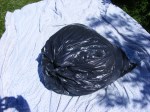
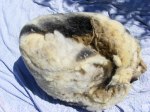
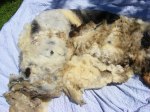
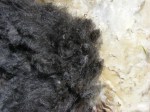
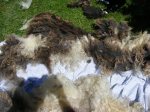
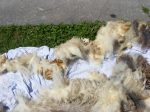
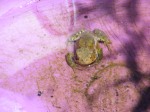
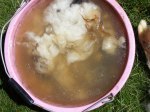
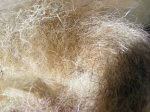
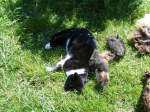

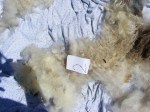
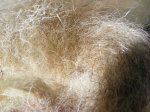

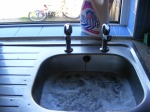
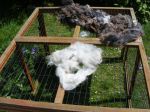


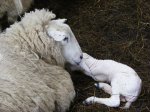


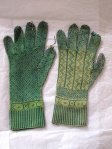
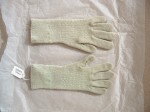
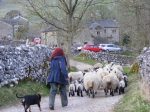









 …And on the fleece sale stall:
…And on the fleece sale stall: Add to that, dancing sheep, a sheep steeplechase, (you can BET on!), craft stalls, plenty of fleece for sale…. you get a grand day out.
Add to that, dancing sheep, a sheep steeplechase, (you can BET on!), craft stalls, plenty of fleece for sale…. you get a grand day out.

















